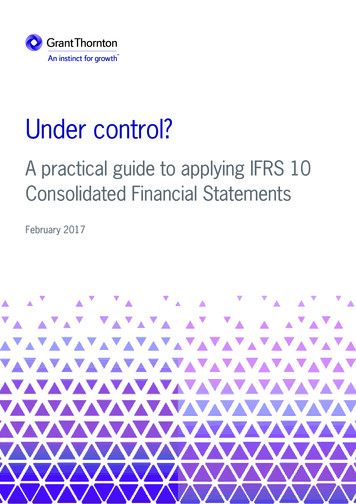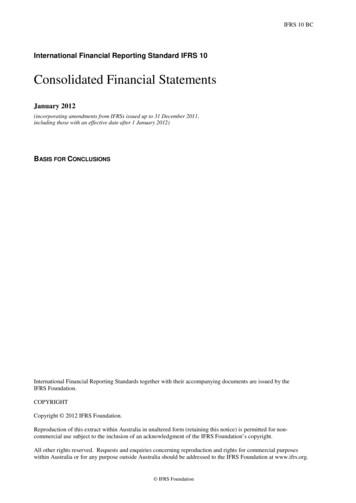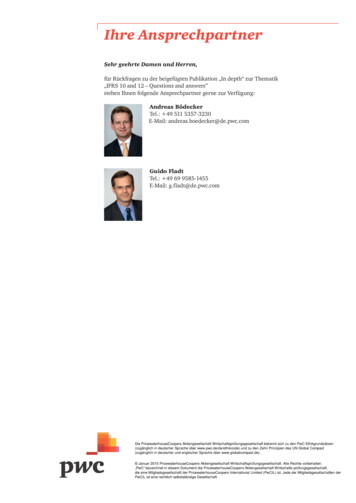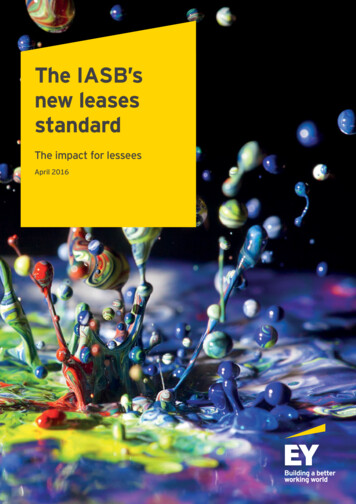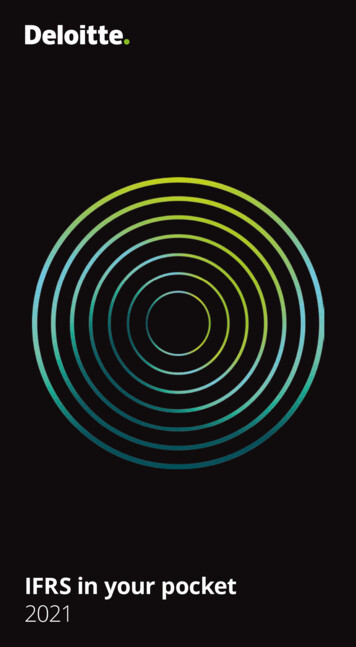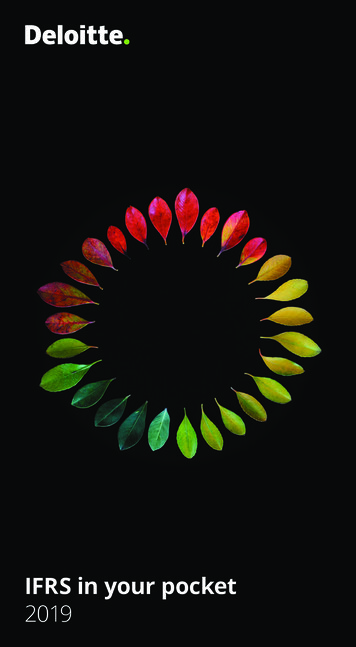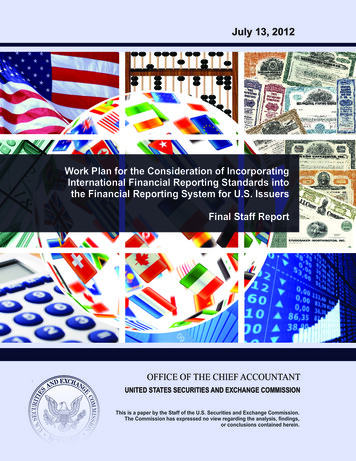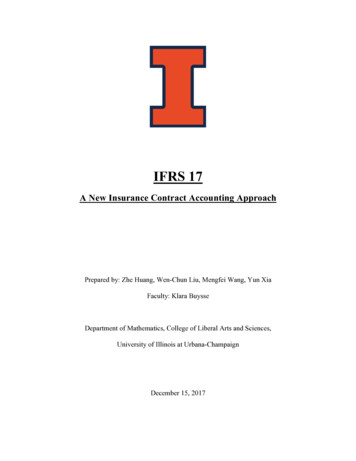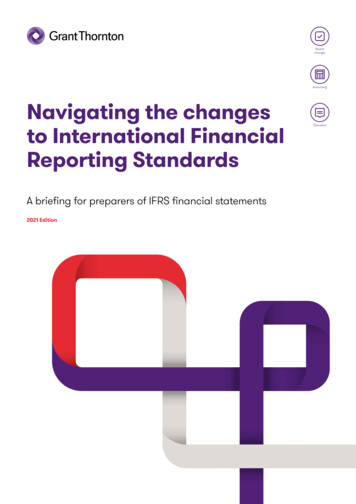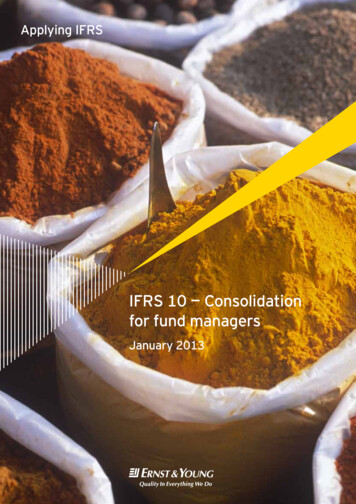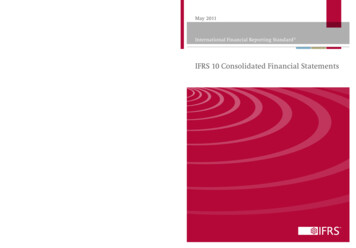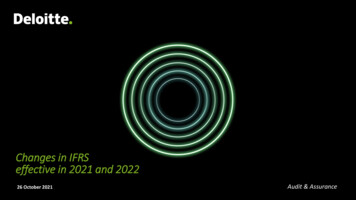
Transcription
Changes in IFRSeffective in 2021 and 202226 October 2021Audit & Assurance
SpeakersAleksanda RytkoSenior managerCE IFRSTechnical DeskE-mail:arytko@deloittece.comtel: 48 664 199 181 2021. Deloitte Central EuropeSoňa PlacháSenior managerCE IFRSTechnical DeskE-mail:splacha@deloittece.comtel: 420 737 235 531Marcin SamolikSenior managerCE IFRS Technical DeskE-mail:msamolik@deloittece.comtel: 48 618 824 257Krzysztof SuperaSenior managerCE IFRS Technical DeskE-mail:ksupera@deloittece.comtel: 48 662 155 548Changes in IFRS effective in 2021 and 20222
IFRS changes effective from 1 January 2021 and later(as at 25. 10. 2021)Amendments to IFRS 3Business CombinationsReference to theConceptual FrameworkAmendments to IAS 1Classificationof Liabilities as CurrentAmendments to IAS 16Property, Plant andEquipment - Proceedsbefore Intended UseAmendments to IAS 1Disclosure of AccountingpoliciesAmendments to IAS 37Provisions, ContingentLiabilites, Contingent AssetsOnerous Contracts – Cost ofFulfilling a ContractInterest Rate BenchmarkReform –Phase 2Amendments to IFRS 4Insurance contracts deferral of IFRS 9Amendments to IFRS 16Leasing - Covid-19Related Rent ConcessionsAnnual Improvements2018–20201 January 20211 April 20211 January 2022 2021. Deloitte Central EuropeEndorsed in the EUNot endorsed in theEUAmendments to IAS 8Definition of AccountingEstimatesAmendments to IAS 12Deferred Tax related toAssets and Liabilitiesarising from a SingleTransactionIFRS 17Insurance Contracts1 January 2023Changes in IFRS effective in 2021 and 20223
IFRS changes effective from 1 January 2021
IBOR reformIFRS 9, IAS 39, IFRS 7, IFRS 16, IFRS 4Krzysztof SuperaSenior ManagerCE IFRS Technical DeskAudit & Assurance Deloitte
Changes in IFRS related to IBOR reform – Phase 1 (2020) and Phase 2 (2021)IFRS 9, IFRS 7, IFRS 16, IFRS 4, IAS 39 For around 50 years IBOR rates (interbank offered rates) have been basis for determination of time value of money in numerous transactions worldwide(loans, borrowings, derivatives, leases, insurance contracts). Currently, the reform of the interest rate market is being conducted. IBOR rates will bereplaced with alternative reference rates, which will be based on executed transactions instead of declarations of market participants (panelists). Starting from the beginning of 2022 some significant LIBOR rates will cease to be published (i.a. CHF LIBOR, GBP LIBOR, EUR LIBOR). Contracts based on variable interest rates have to be amended (changes in interest rate calculation, fallback clauses, spread between IBOR and new rates).Amendments to IFRS being response to the changes in financial markets have been introduced in two phases: Phase 1 amendments provide temporary exceptions for specific hedge accounting requirements impacted by uncertainties arising fromthe reform before an existing interest rate benchmark (IBOR) is replaced with an alternative benchmark interest rate. These amendmentsapply to annual reporting periods beginning on or after 1 January 2020. Phase 2 amendments relate to issues that could affect financial reporting when an IBOR is replaced with an alternative benchmarkinterest rate. The amendments are relevant for many entities and in particular those with financial assets, financial liabilities or leaseliabilities that are subject to the interest rate benchmark reform and those that apply the hedge accounting requirements in IFRS 9 or IAS39 to hedging relationships that are affected by the reform. The Phase 2 amendments apply to annual reporting periods beginning on orafter 1 January 2021.Changes in IFRS related to IBOR reform – Phase 2 (2021)Banks 2021. Deloitte Central EuropeCorporatesInsurersInvestment fundsChanges in IFRS effective in 2021 and 20226
IBOR reform landscape (selected rates)CountryEU*New reference rate STRReference rate full name(administrator)Index being replacedEnd dateEuro Short Term Rate(ECB)EONIA3.1.2022SwitzerlandSARONSecured Overnight Financing Rate(SIX)CHF LIBOR31.12.2021UKSONIASterling Overnight Index Average(Bank of England)GBP LIBOR31.12.2021**USASOFRSecured Overnight Financing Rate(FED)USD LIBOR31.12.2021 (1W, 2M)30.06.2023 (other)**JapanTONATokyo Overnight Average(Bank of Japan)JPY LIBOR31.12.2021 (1W, 2M)30.06.2023 (other)***EUR LIBOR is permanently terminated as at 31.12.2021.**Some LIBOR benchmarks will be available after 31.12.2021 but they will loose their representativeness. It means that the rates may be published but they willnot be based on information provided by panels banks. Instead, these will be synthetic rates. 2021. Deloitte Central EuropeChanges in IFRS effective in 2021 and 20227
IBOR reform – Phase 2Changes in contractual cash flows as a result of the IBOR reformIBOR rateAlternative reference rateIFRS 9.B5.4.5Recalculation of effective interest rate.Effective interest rate calculated based oncontractual cash flows based on IBOR rate.Effective interest rate calculated based oncontractual cash flows based on alternativeinterest rate.No recalculatation ofgross carrying amountfor the changes resultingfrom IBOR reform.New basis for determiningthe contractual cash flows 2021. Deloitte Central EuropeChanges in IFRS effective in 2021 and 20228
IBOR reform – Phase 2Changes in contractual cash flows as a result of the IBOR reform – accounting impactChanges in contractual cash flows of the financial instrumentChanges resulting from IBOR reform.Other changes (payment dates and amounts,currency, credit risk margin, SPPI related features,etc).Practical expedient (IFRS 9:B5.4.5).Recalculation of effective interest rate.Do the changes result in derecognition of financialasset/liability. 2021. Deloitte Central EuropeYESNOApplication of IFRS 9principles relatedto derecognitionof financialassets/liabilities.Gain/loss onmodification(IFRS 9:5.4.3)or changes in expectedcash flows(IFRS 9:B5.4.6).Changes in IFRS effective in 2021 and 20229
Changes in IFRS related to IBOR reform – key challengesMeasurement offinancial assets andliabilities (includinglease liabilities)Hedge accountingOperationalchallenges Required changes in valuation models driven by transition from IBOR to alternative interest rates – fair valuemeasurement. Accounting treatment of changes in contractual cash flows resulting from transition from IBOR to alternativeinterest rates – amortized cost measurement, effective interest rate recalculation, modification result onaccompanying changes in contract, potential impact on SPPI test (in particular: benchmark test). Recalculation of discount rate in lease contracts resulting from transition from IBOR to alternative interest rates. Modification of designated hedge relationships (reflected in hedge documentation). Practical solutions as a response to challenges resulting from transition from IBOR to alternative interest rates. Replacement of existing derivatives. Amendments of the contracts with financial institutions (e.g. borrowings, leases, derivatives). Amendments of the intra-group contracts (e.g. loans, borrowings, derivatives). Amendments in contracts with customers. Changes in IT systems in order to capture changes in EIR, discount rate, modification result, derecognition result.The challenges will materialize mostly after 31.12.2021 however the uncertainties and how the transition fromIBOR to alternative reference rates is managed must be disclosed in FS 2021! 2021. Deloitte Central EuropeChanges in IFRS effective in 2021 and 202210
IBOR reform Phase 2 – disclosure requirementsIFRS 7:24I-24JThe nature and extent ofrisks to which the entity isexposed arising fromfinancial instrumentssubject to interest ratebenchmark reform.How the entity managesthe risks arising fromfinancial instrumentssubject to interest ratebenchmark reform.The entity’s progress incompleting the transitionto alternative benchmarkrates.How the entity is managingthe transition toalternative interest ratesand and the risks to whichit is exposed arising fromfinancial instrumentsbecause of the transition.Quantitative informationabout financial instrumentsthat have yet to transition toan alternative benchmarkrate as at the end of thereporting period, showingseparately:- non-derivative financialassets;- non-derivative financialliabilities;- derivatives.This information shall bedisaggregated by significantinterest rate benchmarksubject to interest ratebenchmark reform. 2021. Deloitte Central EuropeChanges in IFRS effective in 2021 and 202211
IFRS 4 Insurance ContractsKrzysztof SuperaSenior ManagerCE IFRS Technical DeskAudit & Assurance Deloitte
IFRS changes effective from 1 January 2021Amendments to IFRS 4 IFRS 9 addresses the accounting for financial instruments and is effective for annual reporting periodsbeginning on or after 1 January 2018. However, for insurers meeting the eligibility criteria, IFRS 4provides a temporary exemption which permits them to continue to apply IAS 39 Financial Instruments:Recognition and Measurement rather than implement IFRS 9. This temporary exemption was applicable to annual periods beginning before 1 January 2021. In June 2020 the IASB published an amendment to IFRS 4 to extend the temporary exemption fromapplying IFRS 9 until annual periods beginning before 1 January 2023. This amendment maintains thealignment of the effective dates of IFRS 9 and IFRS 17. 2021. Deloitte Central EuropeChanges in IFRS effective in 2021 and 202213
IFRS changes effective from 1 April 2021Marcin SamolikSenior ManagerCE IFRS Technical DeskAudit & Assurance Deloitte
IFRS changes effective from 1 April 2021IFRS 16 and COVID-19 — Extension of practical expedientBackground In May 2020, the IASB issued Covid-19-Related Rent Concessions (Amendment to IFRS 16). The pronouncement amended IFRS16 Leases to provide lessees with an exemption from assessing whether a COVID-19-related rent concession is a leasemodification. On issuance, the practical expedient was limited to rent concessions for which any reduction in lease paymentsaffects only payments originally due on or before 30 June 2021. Since lessors continue to grant COVID-19-related rent concessions to lessees and since the effects of the COVID-19 pandemic areongoing and significant, the IASB decided to look into whether to extend the time period over which the practical expedient isavailable for use.Extension (issued on 31 March 2021): Permits a lessee to apply the practical expedient regarding COVID-19-related rent concessions to rent concessions for which anyreduction in lease payments affects only payments originally due on or before 30 June 2022 (rather than only paymentsoriginally due on or before 30 June 2021). Requires a lessee applying the amendment to do so for annual reporting periods beginning on or after 1 April 2021(in EU from 1 April 2021 for financial years starting, at the latest, on or after 1 January 2021). Requires a lessee applying the amendment to do so retrospectively, recognising the cumulative effect of initially applying theamendment as an adjustment to the opening balance of retained earnings (or other component of equity, as appropriate) atthe beginning of the annual reporting period in which the lessee first applies the amendment (no restatement of comparatives). 2021. Deloitte Central EuropeChanges in IFRS effective in 2021 and 202215
Changes effective from 1 January 2022Soňa PlacháSenior ManagerCE IFRS Technical DeskAudit & Assurance Deloitte
IFRS changes effective from 1 January 2022 (EU endorsed)SummaryStandardTitleAdoption methodIFRS 3Reference to the Conceptual FrameworkProspectivelyIAS 16Property, Plant and Equipment:Proceeds before Intended UseModified retrospective –special rulesIAS 37Onerous Contracts –Cost of Fulfilling a ContractAnnual Improvements 2018–2020Modified retrospective –special rulesDepends on a standardIFRS 1, IFRS 9,IFRS 16, IAS 41 2021. Deloitte Central EuropeChanges in IFRS effective in 2021 and 202217
IFRS changes effective from 1 January 2022 (EU endorsed)Impact for 2021 FS – please remember about IAS 8.30-31requirements to disclose: that an entity has not applied a new IFRS that has beenissued but is not yet effective; and known or reasonably estimable information relevant toassessing the possible impact that application of the newIFRS will have on the entity’s financial statements; note that ESMA require to disclose also impact of newstandards and amendments which are not yet endorsedby EU. 2021. Deloitte Central EuropeChanges in IFRS effective in 2021 and 202218
IFRS 3 Business Combinations:Reference to the Conceptual FrameworkAleksandra RytkoSenior ManagerCE IFRS Technical DeskAudit & Assurance Deloitte
IFRS changes effective from 1 January 2022A brief history of the Framework changes1989Framework for the Preparation and Presentation of Financial Statements2010Conceptual Framework for Financial Reporting 2010 – partially revised2018Conceptual Framework for Financial Reporting 2018 – final version including: revised definitions of an asset and a liability new guidance on measurement and derecognition new guidance on presentation and disclosure Many IFRS standards used to contain references to the previous versions of the Framework. Those references were adequately updated in the 2018 to the newest version of the Frameworkwith an exception for IFRS 3. 2021. Deloitte Central EuropeChanges in IFRS effective in 2021 and 202220
IFRS changes effective from 1 January 2022IFRS 3: Reference to the Conceptual FrameworkCurrently in IFRS 3: 2021. Deloitte Central EuropeWHY? Because IASB needed extra time foranalysis of what would be potentialimpact if the references were eventuallyupdated. In some cases, applying the reviseddefinitions could change which assetsand liabilities qualify for recognitionin a business combination. In some such cases, the post-acquisitionaccounting required by other IFRSStandards could then lead to immediatederecognition of assets or liabilitiesrecognised in a business combination,resulting in so-called Day 2 gainsor losses that do not depictan economic gain or loss.Changes in IFRS effective in 2021 and 202221
IFRS changes effective from 1 January 2022IFRS 3: Reference to the Conceptual FrameworkWhat was amended? In May 2020, the Board: amended IFRS 3:11 to refer to the 2018 version of the Conceptual Framework for Financial Reporting, and amended IFRS 3 in respect of the specific requirements for transactions and other events within the scope of IAS 37 or IFRIC 21: For a provision or contingent liability that would be within the scope of IAS 37, the acquirer shall apply IAS 37 todetermine whether at the acquisition date a present obligation exists as a result of past events. For a levy that would be within the scope of IFRIC 21, the acquirer shall apply IFRIC 21 to determine whether theobligating event that gives rise to a liability to pay the levy has occurred by the acquisition date. The acquirer shall not recognise a contingent asset at the acquisition date.Transitional provisions An entity shall apply those amendments to business combinations for which the acquisition date is on or after the beginning of the firstannual reporting period beginning on or after 1 January 2022. Earlier application is permitted if at the same time or earlier an entity also applies all the amendments made by Amendments toReferences to the Conceptual Framework in IFRS Standards, issued in March 2018. 2021. Deloitte Central EuropeChanges in IFRS effective in 2021 and 202222
IAS 16 Property, Plant and Equipment:Proceeds before Intended UseSoňa PlacháSenior ManagerCE IFRS Technical DeskAudit & Assurance Deloitte
IFRS changes effective from 1 January 2022IAS 16: Proceeds before Intended UseSummary of changesCurrently: Costs and proceeds from selling items during testing phase reflected in the cost of PPE.Amendments: It is prohibited to deduct from the cost of PPE proceeds from selling items producedbefore intended use (activation) of PPE. No additional guidance to determine when the item of PPE is available for use. Clarification what is „testing”. Specific guidance for measurement of cost of sold items from testing is not provided (IAS 2 applies). New disclosure requirement. 2021. Deloitte Central EuropeChanges in IFRS effective in 2021 and 202224
IFRS changes effective from 1 January 2022IAS 16: Proceeds before Intended UseCurrently IAS 16 provides guidance on what shall be considerd as the intial cost of Property Plantand Equipment (PPE) in particular it gives examples of directly attributable costs. Those directly attributable costs include costs of testing whether the asset is functioningproperly, after deducting the net proceeds from selling any items produced whilebringing the asset to that location and condition (such as samples produced whentesting equipment). In practice, different entities had applied this requirement differently: some entities deducted only proceeds from selling items produced while testing; others deducted the proceeds of all sales until an asset was in the location andcondition necessary for it to be capable of operating in the manner intended bymanagement (ie available for use). For some entities, the proceeds deducted from the cost of an item of PPE could besignificant and could exceed the costs of testing. 2021. Deloitte Central EuropeChanges in IFRS effective in 2021 and 202225
IFRS changes effective from 1 January 2022IAS 16: Proceeds before Intended UseWhat was amended? The Board decided to prohibit an entity from deducting from the cost of an item of PPE the proceeds fromselling items produced before that asset is available for use (proceeds before intended use). Arguments: Proceeds before intended use and related cost meet the definition of income and expenses in theFramework and reflect an entity’s performance for the period and they should, therefore, be included inthe statement of profit or loss. The previous requirement reduced the usefulness of financial statements because it resulted in anentity including amounts that did not faithfully represent: its performance. Offsetting proceeds against the cost of an asset understates an entity’s revenue(or income) in the period. Offsetting proceeds decreased the depreciable amount of such an assetand, consequently, reduced the depreciation charge recognised as an expense over the asset’suseful life. the cost of an item of PPE. Offsetting proceeds could result in the carrying amount of the assetunderstating its cost. This, in turn, could reduce the usefulness of financial metrics, such as returnon assets, that use the asset’s carrying amount. 2021. Deloitte Central EuropeChanges in IFRS effective in 2021 and 202226
IFRS changes effective from 1 January 2022IAS 16: Proceeds before Intended UseWhat else was amended? The Board clarified aslo the meaning of testing: assessing whether the technical and physical performanceof the asset is such that it is capable of being used in the production or supply of goods or services, forrental to others, or for administrative purposes. The Board clarified also that the cost of items produced while bringing an item of property, plant andequipment to the location and condition necessary for it to be capable of operating in the manner intendedby management shall be measured in accordance with IAS 2. New disclosure requirement was added:If not presented separately in the SoCI, the financial statements shall also disclose the amountsof proceeds and cost included in profit or loss that relate to items produced that are not anoutput of the entity’s ordinary activities, and which line item(s) in the statement ofcomprehensive income include(s) such proceeds and cost. 2021. Deloitte Central EuropeChanges in IFRS effective in 2021 and 202227
IFRS changes effective from 1 January 2022IAS 16: Proceeds before Intended UseTransitional provisions Retrospectively, but only to items of PPE that are brought to the location and conditionnecessary for them to be capable of operating in the manner intended by managementon or after the beginning of the earliest period presented in the financial statementsin which the entity first applies the amendments. The entity shall recognise the cumulative effect of initially applying the amendmentsas an adjustment to the opening balance of retained earnings (or other componentof equity, as appropriate) at the beginning of that earliest period presented. Application earlier than on 1 January 2022 is permitted. 2021. Deloitte Central EuropeChanges in IFRS effective in 2021 and 202228
IFRS changes effective from 1 January 2022IAS 16: Proceeds before Intended UseExample The entity’s annual reporting period ends on 31 December. It presents only one comparative period. As of 31 December 2020 there were items of PPE under construction whose cost was reduced withCU 1000 of proceeds obtained from selling sample products (costs of the sample products arenegligible as such not included in the example). Addtionally, during 2021 futher proceeds of CU 500 were credited to PPE and the item was activatedin January 2022.Applying IAS 16 amendment In the financial statements for 2022, following adjustments to be made: as of 1 January 2021: Dr PPE under construction1000 CU Cr Retained earnings1000 CUfor the year ended 31 December 2021: Dr PPE under construction500 CU Cr P&L500 CU 2021. Deloitte Central EuropeDisclosurerequirmentChanges in IFRS effective in 2021 and 202229
IAS 37Provisions, contingent liabilities and contingent assets:Onerous Contracts – Cost of Fulfilling a ContractAleksandra RytkoSenior ManagerCE IFRS Technical DeskAudit & Assurance Deloitte
IFRS changes effective from 1 January 2022IAS 37: Onerous Contracts – Cost of Fulfilling a ContractWhat is an onerous contract?An onerous contract is a contract in which the unavoidable costsof meeting the obligations under the contract exceed theeconomic benefits expected to be received under it.But what are they?1. There are differing views whether these shall be: only the incremental costs of fulfilling the contract, or all costs that relate directly to the contract?2. The need for clarification was urgent. Following the withdrawal of previous revenuestandards (IAS 11, IAS 18), entities are required to apply IAS 37 instead of a revenue standardto assess whether contracts are onerous (IFRS 15 does not regulate this matter). PreviouslyIAS 11 specified which costs to include, but IAS 37 did not. 2021. Deloitte Central EuropeChanges in IFRS effective in 2021 and 202231
IFRS changes effective from 1 January 2022IAS 37: Onerous Contracts – Cost of Fulfilling a ContractWhat was amended? The Board decided to require an entity to include all costs that relate directly to a contract. The Board concluded that: including all such costs provides more useful information to users of the entity’s financial statements; the benefits of providing that information are likely to outweigh the costs; and a requirement to include all costs that relate directly to a contract is consistent with otherrequirements in IAS 37 and requirements in other IFRS Standards.Transitional provisions An entity shall apply those amendments to contracts for which it has not yet fulfilled all its obligations atthe beginning of the annual reporting period in which it first applies the amendments (the date of initialapplication). The entity shall not restate comparative information. Instead, the entity shall recognise the cumulativeeffect of initially applying the amendments as an adjustment to the opening balance of retained earningsor other component of equity, as appropriate, at the date of initial application. Application earlier than on 1 January 2022 is permitted. 2021. Deloitte Central EuropeChanges in IFRS effective in 2021 and 202232
IFRS changes effective from 1 January 2022IAS 37: Onerous Contracts – Cost of Fulfilling a ContractExample The entity’s annual reporting period ends on 31 December. As of 31 December 2021 it identified an onerous contract X where the provision was calculated takinginto account only the incremental costs of fulfilling the contract (direct salaries and direct materials). Ifall costs that relate directly to the contract (direct salaries, direct materials and share of productionoverheads) were taken into account, the provision would be higher by CU 100. As of 31 December 2021 the entity considered contract Y for being potentially onerous but concludedthat it was not as the incremental costs of fulfilling the contract did not exceed the expected benefits.However, if all costs that relate directly to the contract Y were taken into account, the provision wouldneed to be recognised at CU 50.Applying IAS 37 amendment In the financial statements for 2022, a following adjustment to be made as of 1 January 2022: Cr Provision for onerous contracts 150 Dr Retained earnings150No adjustments to the comparatives as of 31 Dec 2021 or for 2021 are needed. 2021. Deloitte Central EuropeChanges in IFRS effective in 2021 and 202233
Annual Improvements 2018-2020Marcin SamolikSenior ManagerCE IFRS Technical DeskAudit & Assurance DeloitteKrzysztof SuperaSenior ManagerCE IFRS Technical DeskAudit & Assurance Deloitte
IFRS changes effective from 1 January 2022Annual Improvements 2018-2020StandardSubject of amendmentIFRS 1 First-time Adoption ofIFRSSubsidiary as a first-time adopter and voluntary exemptionregarding cumulative translation differencesIFRS 9 Financial InstrumentsFees in the „10 per cent” test for derecognition of financialliabilitiesIllustrative Examples to IFRS 16 Lease incentivesLeasesIAS 41 AgricultureTaxation in fair value measurement Generally, application earlier than on 1 January 2022 is permitted. 2021. Deloitte Central EuropeChanges in IFRS effective in 2021 and 202235
IFRS changes effective from 1 January 2022Annual Improvements 2018-2020IFRS 1 First-time Adoption of IFRS Paragraph D16(a) of IFRS 1 allows subsidiaries that become a first-time adopter later than its parent tomeasure its assets and liabilities at the carrying amounts that would be included in the parent’s consolidatedfinancial statements. The issue was that D16(a) does not cover equity items like cumulative translation differences. It is an issue fora subsidiary which has its own capital group, with foreign operations or has branches which are foreignoperations. A subsidiary that uses the exemption in paragraph D16(a) may elect, in its financial statements, to measurecumulative translation differences for all foreign operations at the carrying amount that would be included inthe parent’s consolidated financial statements, based on the parent’s date of transition to IFRSs, if noadjustments were made for consolidation procedures and for the effects of the business combination inwhich the parent acquired the subsidiary. A similar election is available to an associate or joint venture that uses the exemption in paragraph D16(a). 2021. Deloitte Central EuropeChanges in IFRS effective in 2021 and 202236
IFRS changes effective from 1 January 2022Annual Improvements 2018-2020IFRS 9 Financial Instruments IFRS 9 Financial Instruments requires an entity to derecognise a financial liability and recognise a newfinancial liability when there is an exchange between an existing borrower and the lender of debtinstruments with substantially different terms (including a substantial modification of the terms of anexisting financial liability or part of it). The terms are substantially different if the discounted present value of the remaining cash flows under thenew terms are at least 10 per cent different from the discounted present value of the remaining cash flowsof the original financial liability (‘10 per cent’ test). The amendment clarifies which fees an entity includes when it applies the ‘10 per cent’ test in assessingwhether to derecognise a financial liability. An entity includes only fees paid or received between the entity (the borrower) and the lender, includingfees paid or received by either the entity or the lender on the other’s behalf. The amendment is applied prospectively to modifications and exchanges that occur on or after the date theentity first applies the amendment. 2021. Deloitte Central EuropeChanges in IFRS effective in 2021 and 202237
IFRS changes effective from 1 January 2022Annual Improvements 2018-2020Illustrative Examples to IFRS 16 Leases Illustrative Example 13 of IFRS 16 Leases includes as part of the fact pattern a reimbursement relating toleasehold improvements. The example does not explain clearly enough the conclusion as to whether thereimbursement would meet the definition of a lease incentive in IFRS 16. To resolve any potential confusion regarding the treatment of lease incentives, the amendment nowremoves the illustration of the reimbursement of leasehold improvements. As the amendment to IFRS 16 only regards an illustrative example (non obligatory part of IFRS), so noeffective date is stated. 2021. Deloitte Central EuropeChanges in IFRS effective in 2021 and 202238
IFRS changes effective from 1 January 2022Annual Improvements 2018-2020IAS 41 Agriculture In 2008, the IASB removed from IAS 41 Agriculture the requirement to use a pre-tax discount rate whenmeasuring fair value. However, at that time, it did not remove from IAS 41:22 the requirement to use pretax cash flows when measuring fair value. To resolve this conflict, the IASB now removed the requirement in IAS 41 for entities to exclude cash flowsfor taxation when measuring fair value. This aligns the fair value measurement in IAS 41 with therequirements of IFRS 13 Fair Value Measurement to use internally consistent cash flows and discount ratesand enables preparers to determine whether to use pre-tax or post-tax cash flows and discount rates forthe most appropriate fair value measurement. The amendment is applied prospectively, i.e. for fai
In June 2020 the IASB published an amendment to IFRS 4 to extend the temporary exemption from applying IFRS 9 until annual periods beginning before 1 January 2023. This amendment maintains the alignment of the effective dates of IFRS 9 and IFRS 17.
